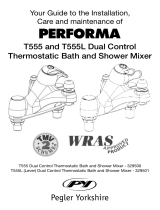
6
IMPORTANT INFORMATION
Professional installation
We recommend that our products are fitted
by a fully qualified professional plumber. They
should be installed correctly and in accordance
with all local water regulations. All products and
connections should be accessible for routine
servicing.
Suits all systems
This Lefroy Brooks product is potentially
suitable for every possible application, type of
boiler and water supply pressure. However, for
full ‘power’ shower performance it is advisable
to fit a water pump if the supply pressure is
below 1 bar. For systems with combination
boilers, it is not advisable to fit pumps (refer
to boiler manufacturer).
Recommended supply temperatures
HOT = 55/60°C
COLD = 10/15°C
Water quality
In hard water areas, a suitable water treatment
system should be provided to prevent limescale
deposits (calcium deposits) which may eect
the long term performance of the thermostatic
cartridge. Exterior surfaces should be gently
wiped with a dry soft cloth after use to minimise
water stains and limescale deposits.
Servicing
All serviceable parts are available to maintain
your Lefroy Brooks product. We recommend
periodic servicing to help maintain the best
performance from your shower (‘Servicing the
thermostatic cartridge’ & ‘Replacing the
non-return valve’ sections). Time between
servicing can vary as it is subject to usage and
water quality.
Flushing system
It is most important to flush out all pipework
thoroughly before connecting the product.
Failure to do so is the single most common
cause of ceramic cartridge and thermostatic
cartridge failure.
Supply connections
The hot water supply must be connected to the
left port and cold water to the right port
as viewed from the front.
Balancing flow
If there is a significant dierence in water
pressures between hot & cold supplies, we
recommend an in-line flow suppressor/
regulator (not supplied) be fitted. This should be
fitted to whichever has the greater flow rate, in
an accessible position close to the valve.
Safety/Anti-scald
This thermostatic valve not only maintains a
constant temperature to approximately plus
or minus 1°C, but will automatically shut down
completely on failure of hot or cold supplies.
Temperature setting
Once the installation has been completed the
‘safe temperature’ must be checked and set
in accordance with the setting instructions
(see following ‘Setting safe temperature’ &
‘Fitting the temperature override’ sections).
The valve is factory set but the working
temperature may dier subject to the hot & cold
water temperatures being supplied to the valve.
















